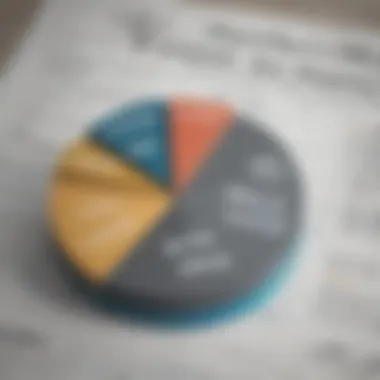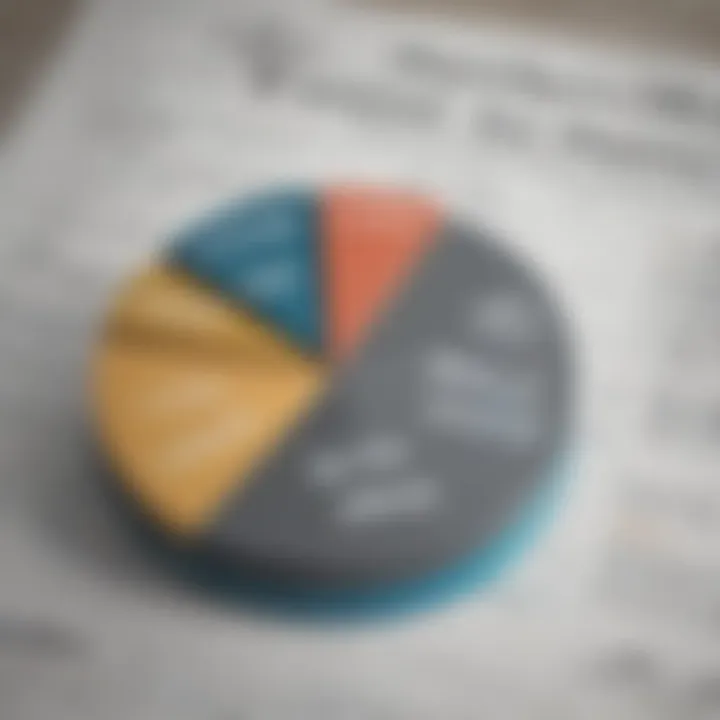Strategies for Paying Down Your Mortgage Principal


Intro
Navigating the maze of mortgage repayment can often feel like an uphill battle. For many, understanding how extra payments on the principal can alleviate financial burdens is crucial. Not only does it potentially shorten the life of the loan, but it can also lead to significant savings on interest over time. This article digs deep into various strategies for making additional payments toward your mortgage principal, offering a blend of practical advice and financial wisdom that can be valuable whether you're a new homeowner or a seasoned investor.
Investment Dictionaries
Glossary of Key Terms
To successfully maneuver through the world of mortgages, it's imperative to familiarize oneself with key terms. Below is a glossary that simplifies complex jargon.
- Principal: The original sum of money borrowed in a loan.
- Interest: The cost of borrowing money, expressed as a percentage of the principal.
- Amortization: The process of gradually paying off a loan through scheduled payments that cover both principal and interest.
- Extra Payments: Payments made above the scheduled monthly amount, directed toward reducing the principal.
Investment Jargon Explained
Investing in property or addressing existing mortgage commitments requires one to grasp the nuanced language that often dominates financial discussions. The implication of making extra payments on the principal isn't just about the numbers; it encapsulates a mindset focused on long-term stability. Most homeowners fail to realize the substantial advantage in paying down principal early on, resulting in less debt over time.
Understanding the Impact of Extra Payments
Extra payments on your mortgage principal can have noteworthy consequences. On the surface, it might seem like just throwing money at a problem. However, a closer look reveals that this tactic is grounded in financial prudence.
- Reduced Interest Costs: Paying down the principal directly corresponds to the amount of interest you pay. The lower the principal, the less interest accrues over the life of the loan.
- Shortened Loan Term: By making additional payments, homeowners can potentially cut years off their repayment schedule. This leads not only to financial savings but also to a sooner path toward owning one's home outright.
Examples in Real Life
Consider a homeowner with a $300,000 mortgage at 4.5% interest over 30 years. If they decide to make an additional $200 payment each month, they could save over $30,000 in interest and pay off the loan about five years early. It's straightforward math that can have monumental effects on one's financial landscape.
"The sooner the principal is reduced, the less interest you pay overall. In finance, time is often money."
Exploring Payment Strategies
Understanding which strategies to adopt is as vital as comprehending the reasons behind them. Here are a few methods to consider:
- Lump-Sum Payments: When unexpected cash comes your way—maybe a bonus from work—consider putting a chunk towards the principal.
- Bi-Weekly Payments: Instead of monthly payments, splitting your mortgage into bi-weekly installments means you’re making one extra payment each year.
- Refinancing to a Shorter Term: Sometimes, refinancing for a shorter loan period comes with lower rates, thereby allowing more of each payment to go toward the principal.
Culmination
Plotting a course for mortgage principal payments offers numerous benefits that go beyond mere numeric values. It encapsulates a lifestyle choice towards financial well-being and smart planning. Whether you're just breaking ground on your first home or managing multiple properties, these strategies provide clarity. It's about crafting a healthier financial future equipped with the tools and knowledge needed to navigate this daunting landscape with confidence.
Understanding Mortgage Basics
When diving into the world of mortgages, grasping the basic concepts can be your foundation. This understanding is crucial not just for managing your payments but also for strategizing how to pay down your mortgage principal effectively. Knowing the essentials helps you recognize various components, evaluate choices, and envision the long-term effects on your financial health.
What is a Mortgage?
A mortgage is a type of loan specifically designed for purchasing real estate. When you take a mortgage, you are essentially borrowing money from a lender with the promise to pay it back over a specified period. This kind of loan allows you to buy a home without needing to pay the entire price upfront.
However, the mortgage isn't just a simple loan; it is also a legal agreement. If you fail to make your payments, the lender has the right to take possession of the property through foreclosure. Therefore, it is essential to understand every aspect of the mortgage process to avoid costly pitfalls and make informed decisions over time.
Elements of a Mortgage Payment
A mortgage payment consists of several key elements, each playing a role in your overall financial commitment. Let's take a closer look:
Principal
The principal refers to the initial loan amount you borrow from the lender. When you make a payment toward the principal, you are reducing the remaining balance on your mortgage. This is a significant aspect to focus on because the lower the principal, the less interest you’ll pay over time. Reducing the principal accelerates equity building in your home, which can be a powerful financial leverage tool.
As you chip away at that principal, you can notice a positive spiral effect on your long-term financial stability. It’s quite beneficial to prioritize principal repayment in your strategy.
Interest
Interest on a mortgage is essentially what the lender charges you for allowing you to borrow the money. It's a percentage of the remaining loan amount, and as you pay down the principal, the interest amount will decrease over time. Many homeowners find that a significant part of their payment goes towards interest in the early years of the mortgage.
This is an important feature to be aware of because making extra payments toward the principal can drastically reduce the total interest you pay over the life of the loan. In a nutshell, when you lower your principal, you inherently cut down on the interest charges, which is a win-win situation.
Taxes
Mortgage payments often include property taxes that the homeowner is responsible for paying. These taxes are typically collected by the lender and placed in an escrow account until they are due to the local government. If you’re not prepared for the tax situation, it could lead to a big financial surprise down the road.


Understanding your tax responsibilities is crucial since these amounts can change based on local assessments. Failing to pay taxes can affect your property ownership—it’s not just about the mortgage, but about your overall financial environment.
Insurance
Homeowners insurance protects both you and the lender against damages to the property. This cost is often factored into your mortgage payment, providing a safety net against unforeseen events. Similar to taxes, the costs associated with insurance can fluctuate based on market conditions and risk factors.
Plus, in many cases, if you put down less than 20% on the home, you may also be required to pay private mortgage insurance (PMI). So, having a clear understanding of insurance obligations can help you budget effectively and avoid surprises.
In summary, by breaking down these elements—principal, interest, taxes, and insurance—you’ll better appreciate the broader financial intricacies at play. This knowledge can empower you to define effective strategies for paying down your mortgage, especially with an eye toward reducing the principal.
The Importance of Principal Payments
When it comes to mortgages, the significance of principal payments can't be overstated. Simply put, principal is the part of the mortgage loan that goes directly toward paying off the original amount you borrowed. Focusing on principal payments leads to a host of advantages that can drastically alter one's financial landscape.
First and foremost, making additional principal payments resonates well with the concept of reducing overall debt. When you allocate more of your payment to principal, it's like chipping away at that mountaintop of debt. This not only brings the balance down but also affects other financial aspects down the line, such as interest rates. The lower your balance gets, the less interest you'll end up paying. It's a powerful way to accelerate your journey toward owning your home free and clear.
How Principal Payments Affect Interest
One of the primary factors affecting the total amount you pay over the life of your mortgage is the interest accrued. Interest on a mortgage is calculated based on the principal balance. Thus, reducing your principal through extra payments directly lowers the amount of interest you owe over time.
For instance, let's say you have a mortgage for $300,000 with an interest rate of 4%. If you only make the minimum payments, you'd pay thousands in interest over 30 years. However, if you decide to pay an additional $200 each month towards your principal, you can potentially save tens of thousands in interest and shorten the term of your loan. It’s like throwing a lifeline to your financial health.
Impact on Loan Duration
One of the most compelling reasons to pay extra toward your principal is the significant reduction in the length of the mortgage. By lowering the outstanding balance more quickly, you effectively shorten the amortization period. This means you’ll be free and clear of your mortgage in fewer years than anticipated.
Consider this: a 30-year mortgage could potentially turn into a 25-year or even a 20-year one, all because of those additional payments. This extra effort not only saves you money on interest but also provides peace of mind. Knowing that you are that much closer to owning your property outright can be quite freeing. You can shift your focus onto other financial goals, be it retirement funds or real estate investments.
Building Equity in Your Home
Equity is essentially the difference between what your home is worth and what you owe on your mortgage. As you make your monthly payments, you’re naturally building equity. However, putting more money toward the principal accelerates that process.
Each dollar you pay over and above your monthly requirement not only reduces your debt but also enhances your ownership stake in your home. For instance, if you bought a house for $400,000 and your mortgage left you with $300,000 owed, extra principal payments can bump your equity up significantly in a short time. This equity could prove invaluable when considering future investments or in case of emergencies.
"Paying extra on your principal isn't just for making the lender happy; it's a strategic move that can fundamentally change your financial future."
In summary, focusing on principal payments provides tangible benefits: saving on interest, shortening loan duration, and building equity. Each of these factors plays an essential role in creating a solid financial foundation. Recognizing the potential impact of these payments can prove vital for investors, financial advisors, and individuals looking to enhance their mortgage management strategies.
Strategies for Paying Extra Toward Principal
Paying extra toward the principal of your mortgage might sound like a tedious chore, but it could be one of the most astute moves you can make in your financial journey. This approach does more than reduce the debt; it can transform your financial landscape by minimizing your interest and shortening the loan duration. As you explore various strategies, recognize that these actions require thoughtful consideration. How can you best leverage your financial resources? Let’s examine specific methods that are not only practical but can also yield significant rewards.
Making One-Time Lump Sum Payments
One-time lump sum payments offer a distinct advantage when aiming to pay down mortgage principal. These payments can stem from various sources: tax refunds, bonuses from work, or even the sale of an item you no longer need. The key here is timing—making a lump sum payment during a favorable period can maximize the impact on your total interest paid.
Imagine receiving a tax refund of $3,000. Instead of using that money for a vacation or new gadgets, consider applying it directly to your principal.
Benefits include:
- Immediate Impact: A lump sum payment directly reduces your principal balance, making a noticeable dent in the amount of interest you’ll be paying over time.
- Loan Term Reduction: By decreasing the principal, you might finish your mortgage several years sooner—thus liberating your financial obligations.
However, make sure to check your loan agreement for any potential prepayment penalties, as some institutions may impose a fee for paying off a significant amount ahead of schedule. Keep your financial health front and center, ensuring that this strategy aligns well with your overall goals.
Choosing to Accelerate Payments
Choosing to accelerate your payments can pave a faster path toward mortgage freedom. This can mean opting for bi-weekly payments instead of monthly ones, a strategy that effectively results in making one additional full payment each year.
For instance, if your monthly mortgage payment is $1,200, switching to bi-weekly payments of $600 means you'll end up paying $1,200 for that "extra" month every year. Here are some advantages of acceleration:
- Interest Savings: Paying more frequently leads to lower principal balances sooner, reducing the amount of interest charged on remaining principal.
- Increased Home Equity: Accelerating payments enhances equity in your home, which can be valuable for future borrowing or selling purposes.
It's important to consider your cash flow—if you find yourself living paycheck to paycheck, this approach might not be viable. Yet, for those with some flexibility in their budgets, it can become a powerful tool in your arsenal.
Applying Windfalls and Bonuses
Applying unexpected windfalls—like work bonuses or inheritances—can significantly chip away at your mortgage. This strategy hinges on the recognition that these are funds you didn’t anticipate; thus, using them for a lump-sum payment can yield dividends that stretch beyond immediate satisfaction.


Let’s take an example: Say you receive a $5,000 bonus at work. Instead of splurging on a luxury item, plow that sum into your mortgage. By making such targeted moves, you:
- Dramatically Reduce Loan Life: As mentioned, shorter loan terms equate to less interest.
- Fortify Financial Resilience: Less debt means less financial weight on your shoulders, enabling you to maneuver through life’s twists and turns with greater ease.
Of course, these windfalls can easily dissipate if not carefully managed. One must prioritize—always aligning these unexpected boosts with long-term financial goals rather than allowing them to get lost in the daily grind.
Ultimately, every dollar counts. Positioning your resources wisely can ensure meaningful impact on your mortgage and greater financial freedom overall.
Each of these methods requires forethought, and it's wise to periodically check whether they fit into your broader financial plan. With a solid strategy in hand, you can pave the way to becoming mortgage-free sooner than you might think.
Considerations Before Making Extra Payments
When it comes to managing a mortgage, throwing extra funds at the principal can seem like a no-brainer. However, there are several essential considerations to mull over before making those extra payments. It's not just about the immediate benefits but also understanding the broader financial picture.
Assessing Your Financial Situation
Before committing to additional mortgage payments, it’s wise to take a closer look at your overall financial situation. Dive deep into your budget, looking into your income, expenses, and any other debts you might have. If you find yourself living paycheck to paycheck, it might not be the best move to allocate extra funds toward your mortgage. In fact, you should consider the implications of liquidity.
Here's a quick checklist for you:
- Budget Review: Ensure all your essential expenses are covered.
- Emergency Fund Status: Do you have at least three to six months of expenses saved up?
- Debt-to-Income Ratio: How much of your income is going toward debts outside your mortgage?
Determining your financial health can help you see if paying down the mortgage more aggressively is feasible or if it might stretch your resources too thin.
Understanding Prepayment Penalties
Don’t forget to read the fine print of your mortgage agreement. Some loans come with prepayment penalties for making extra payments or paying off the loan early. These penalties can be a real kicker, eating into your potential savings. They vary widely based on the lender and the terms of the mortgage. So, before you start sending off those extra checks, check if your bank has any restrictions or penalties in place.
"Knowing the conditions tied to your mortgage might save you a boatload in the end."
It’s crucial to understand the details to avoid unexpected expenses that could make your well-intentioned extra payments less beneficial than imagined.
Evaluating Other Investment Opportunities
When you contemplate making extra payments on your mortgage, don’t put on blinders. Think about other investment opportunities that could potentially yield higher returns. The stock market, bonds, or contributing more to retirement plans can sometimes offer better long-term gains than paying down a mortgage.
Consider these factors:
- Potential Returns: What could your money earn in an investment compared to the interest saved on your mortgage?
- Risk Assessment: Are you willing to take on more risk for the chance of higher returns?
- Diversification: Is it time to spread your investments across different assets?
Weighing these aspects can lead you to smarter financial choices beyond just the mortgage table.
Tools for Managing Mortgage Payments
Understanding and efficiently managing mortgage payments requires not just commitment but also the right tools. In today's digital age, there are more resources available than ever to help homeowners and investors effectively navigate their mortgage obligations. Leveraging these tools can mean the difference between a confused approach and a well-strategized plan for reducing principal.
Mortgage Calculators
Mortgage calculators are indispensable tools for any homeowner intent on understanding their payments and planning their future. These online calculators can break down monthly payments, show how much of that payment is going towards principal versus interest, and illustrate the impact of making extra payments. Different scenarios can be simulated, which allows you to see how increasing your payment slightly each month can drastically reduce both the length of your loan and total interest paid over time.
"A penny saved is a penny earned"—and with mortgage calculators, you can often save thousands by understanding how to allocate your funds efficiently.
Besides monthly payment calculations, many calculators can project your loan amortization schedule. This is a detailed breakdown of every payment you'll make over the life of the loan, showing how much interest and principal will go into each payment. Knowing this information can inspire many homebuyers to make those extra payments.
Creating a Payment Schedule
Establishing a payment schedule is another key tool in managing mortgage payments. It’s less about adhering to what your lender expects and more about tailoring a plan that fits into your financial landscape.
You might discover that paying bi-weekly instead of monthly, for instance, can help you shave off some years from your mortgage life. This method essentially lets you make one extra payment a year without feeling the pinch.
Steps to create an effective schedule include:
- Assess your monthly budget. Determine how much extra you can realistically apply toward your mortgage each month.
- Set clear goals. Are you aiming to reduce principal faster, pay off your mortgage early, or save on interest?
- Monitor progress. Regularly review your payment schedule to see if it's still working for you or if adjustments are needed.
Using Financial Management Software


Financial management software can integrate mortgage payment tracking into your broader financial landscape. Tools like Mint, YNAB (You Need A Budget), or Quicken allow tracking your mortgage alongside other expenses, giving a holistic view of your financial wellbeing.
Such software can help you:
- Forecast your financial future with projections based on various scenarios, including unexpected costs and life events.
- Set reminders for payments and even integrate them with your bank accounts.
- Track savings for emergencies, which can affect how freely you might want to put money toward your mortgage.
Having a tool that combines multiple facets of your financial life makes it easier to see where adjustments can be made without compromising your other financial goals. The key is to find a balance that allows you to pay off your mortgage without sacrificing your financial freedom or stability.
Utilizing these tools can position you to make better informed, more calculated decisions regarding your mortgage payments, ultimately leading to a more favorable financial outcome.
Long-Term Benefits of Paying Toward Principal
Paying extra toward the principal of your mortgage may seem like a simple endeavor, but its long-lasting impacts are profound. The act of chopping away at the principal not only diminishes the amount owed, it also paves several beneficial pathways in your financial journey. The lower the principal balance, the less you pay in interest over time and the closer you are to owning your home outright. This section delves into those long-term benefits, highlighting why making extra payments on the principal isn't merely a mundane task but rather a powerful financial strategy.
Reduction in Total Interest Paid
One of the most striking advantages of making additional payments toward your mortgage principal is the reduction in total interest paid over the term of the loan. Mortgage interest can amount to a significant pile of cash that ultimately ends up in the hands of lenders. By decreasing the principal balance, you effectively decrease the interest charged for subsequent payments. For example, consider a mortgage of $300,000 at a 4% interest rate with a 30-year term. Without prepayments, over the life of the loan, you could pay nearly $215,000 just in interest! However, if you apply an extra $200 every month to the principal, it could reduce your interest payments by nearly $80,000. That’s real money saved.
"Every dollar you put against the principal not only attacks the balance but also whittles down the interest that’s piled on over time."
Faster Path to Mortgage Freedom
With interest reduced, another clear benefit arises—speed. Making additional payments toward your principal diminishes the total loan balance, accelerating the timeline to full ownership. Validating this point, many individuals notice they can shave several years off their mortgage term entirely. There’s a psychological aspect at play; the quicker you chip away at that principal, the closer you get to landing on the other side, mortgage-free. The freedom that comes with no longer being tied to monthly payments—and the weight that lifts from your shoulders—is invaluable. One homeowner shared, "When I finally paid it off, I felt like I was on a cloud. It’s more than financial; it’s a triumph."
Improved Financial Flexibility
Paying down your mortgage principal establishes a bedrock of financial flexibility. Lower monthly payments—due to reduced interest—affords room within your budget for other expenses. It may even present opportunities for investments or savings, shaping a more stabilized financial portfolio. The reduction in debt also improves your overall debt-to-income ratio, making you a more attractive candidate for future loans or credit lines.
In a world where financial burdens can feel insurmountable, each extra dollar towards the principal builds a buffer. Homeowners can seize opportunities, whether that’s funding a child's education, investing in a promising venture, or just padding a retirement account. Financial experts consistently highlight that those who prioritize paying their mortgage down early often find themselves in a better position to weather unexpected storms.
Potential Drawbacks to Consider
When diving into the world of paying extra toward your mortgage principal, it's imperative to keep an eye on the potential drawbacks. While the idea of reducing your mortgage faster tends to shine brightly, exploring the nuances behind these strategies reveals a more complex picture.
Liquidity Concerns
One of the most significant factors to weigh is liquidity. Simply put, liquidity refers to how easily an asset can be converted into cash. When you decide to make extra payments toward your mortgage, this can severely limit your cash flow. You may think, "What difference does a few hundred dollars make?" But, stacking extra principal into your mortgage locks that money into a fixed asset rather than leaving it free in your account.
Consider this: if your budget suddenly tightens due to unexpected expenses—say, a medical bill or car repair—having less cash on hand could mean tough choices ahead. You might find yourself in a tight spot, all for the sake of a lower mortgage balance. It's wise to assess your overall financial landscape before heading down the extra payment route.
"Liquidity is like oxygen; we hardly notice it until it's gone."
Opportunity Costs of Capital
Opportunity costs also deserve honest consideration. This concept refers to what you give up when you decide to allocate resources—like extra cash—toward one choice over another. For instance, if you put additional funds into your mortgage, you might miss chances to invest that money elsewhere, potentially yielding higher returns.
Imagine you have an option to invest in a well-performing stock or real estate venture, both with a promising ROI. Diverting those funds to pay your mortgage might feel responsible, but it can cost you potential growth. You may have heard the phrase, "A penny saved is a penny earned," but in the realm of investing, those pennies could multiply in unexpected ways.
To put it more plainly, simply ignoring other investment opportunities might lead to a slower rate of wealth accumulation. Striking a balance between reducing debt and fostering growth through wise investments is essential, as each choice shapes your financial journey.
In summary, while tackling mortgage principal seems beneficial, keeping liquidity concerns and opportunity costs on your radar is crucial. Without this understanding, your plans might hit a snag, causing unforeseen challenges down the line.
Epilogue
In wrapping up our discussion on strategies for paying toward the principal of a mortgage, it’s crucial to underline not just the steps but the essence of our findings. Making extra payments on the principal can seem like a mere financial exercise at first glance, yet its impacts echo throughout the entirety of a mortgage journey. By reducing principal balance more swiftly than scheduled, borrowers can secure a myriad of benefits that extend well beyond immediate financial relief.
Summarizing Key Insights
One of the notable insights gleaned from this exploration is the profound effect that principal payments have on reducing overall interest. Each extra dollar paid toward the principal diminishes the amount owed, subsequently lowering the interest accrued over time. This means less money spent on interest overall, allowing homeowners to channel those funds toward other ambitions, such as saving for retirement or investing in property.
Moreover, understanding that a shorter loan duration results from these extra payments cannot be overstated. A mortgage that might have taken, say, 30 years, can often be trimmed down to a decade or so with consistent, additional payments. This shortened timeline not only fosters financial freedom but also enhances one's equity position, which can be a powerful tool in the market.
To delineate the crux of our findings:
- Extra payments lower total interest costs.
- Accelerated payment strategies can shorten loan terms.
- Building equity helps in future financial endeavors.
This understanding creates a robust framework for anyone looking to take charge of their mortgage, making it essential for both new homeowners and seasoned investors alike.
Final Thoughts on Mortgage Management
In final contemplation, adopting a judicious approach to mortgage management is paramount. While the prospect of paying more towards principal may initially daunt some homeowners, the long-term advantages far outweigh the momentary sacrifice of liquidity.
Protecting one’s financial health involves evaluating various factors, including consistent income, individual financial goals, and potential prepayment penalties. A strategy that works harmoniously with one’s budget and future aspirations will not just ease the burden of debt but also pave the way toward financial independence.
So the next time you ponder the prospect of an extra principal payment, remember: It's not merely about numbers on a monthly statement, but rather a step toward owning your financial destiny with confidence. Embrace these insights, weigh your options, and proceed with a strategy that showcases your financial acumen.



